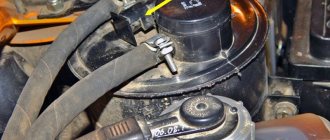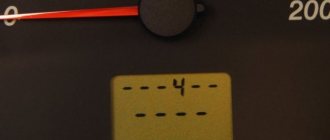P0135 is an oxygen sensor (bank 1, sensor 1) heated circuit fault. This error code tells the driver that there is a malfunction in the heating mechanism of the first lambda probe, the one installed before the converter. Error p0135 can be determined using a car scanner or self-diagnosis (using a paper clip and counting the blinks of the check icon on the instrument panel). Since there may not be other symptoms indicating a problem with heating the oxygen sensor.
Reasons for error P0141
There are not many possible reasons that could signal the controller to set error code p0141:
- Loss of contact in the lambda probe power supply;
- Fume of the oxygen sensor heating coil;
- Installing a different type of sensor.
Therefore, if the goal is to get rid of the annoying light on the dashboard that reminds you of a problem with the oxygen sensor after the catalyst, then you should start looking for the problem by checking the condition of the contacts and wiring of the sensor.
The ECU checks the oxygen sensor heater circuit upon first start-up and detects an open or short circuit or increased current consumption in the lambda probe heater circuit.
Is it possible to drive with P0135?
Older injection systems initially retain a “wait” for warming up, that is, in the worst case, fuel consumption will slightly increase (due to the fact that reaching the “closed loop” during warming up will begin to lag). Many cars easily drive several thousand until the owner gets tired of the Check Engine light being on.
This is interesting: The central locking does not work: how to repair it yourself?
In the future, this emergency algorithm was preserved, the only “but” in the larger “choke” under strict economic standards. That is, a modern car will not experience serious problems with faulty heating if the sensor itself is working properly.
However, if the error occurs randomly (that is, after a reset, not immediately after turning on the ignition, when the self-test is running, but with a random delay or even while driving), then this indicates more serious problems. Thus, there are known cases when, to eliminate error P0135, dealers replaced defective wiring harnesses on Kia Ceed. If the error occurs due to a bad contact on the ECU connector, then it is unlikely that the problem is only in one contact out of several dozen (or even more than a hundred), there may be further “surprises”.
Therefore, the answer is simple: you can drive with a faulty heated upstream oxygen sensor. But with error P0135 without establishing the exact cause of its occurrence, it is extremely undesirable.
How does a car behave with error P0130?
Error P0130, indicating problems with the voltage in the oxygen sensor circuit, directly affects engine performance. The most noticeable consequences of its occurrence are at high speeds of a car engine. The driver can expect the following troubles:
- Increased fuel consumption;
- Unstable engine operation at high speeds;
- Loss in dynamics - the car will begin to accelerate more slowly, and even with increased pressure on the gas pedal, the situation will not change.
Most often, the consequences of the P0130 error do not appear immediately.
It is important to note that driving a vehicle diagnosed with P0130 is extremely dangerous in terms of increasing the likelihood of failure of expensive engine components.
Signs of an error
In most cases, the presence of an error in the oxygen sensor heating power supply circuit is indicated by the following signs:
- turning on the “Check engine condition” light under number P0135;
- slight increase in fuel consumption with no changes in driving rhythm;
- loss of dynamics when the car picks up speed;
- heavier or more hysterical sounds at the moment of exhaust;
- a change in the usual smell of exhaust gases (it becomes sharper, more pungent and is strongly felt even in the cabin).
Symptoms of malfunction
Since there are one or two reasons, many do not even try to check the lambda probe, but immediately change it at the slightest suspicion of losing its functions (especially at a service station), but if you are doing it for yourself, then, of course, it’s worth checking and inspect the contacts, pay attention to all signs of malfunction of the lambda probe.
You will need an inspection hole, since the oxygen sensor is located behind the catalyst, and remove the power connector from it. Surely it will be completely covered with greenish oxide. Also look at the wires coming from the connector, because there is a possibility that one of the wires is broken or shorted.
To make a correct verdict about the serviceability of the oxygen sensor, it is very important to know the nominal resistance of the sensor heating, since at a temperature of 20 °C it is lower when the engine is warm, when the exhaust temperature is higher than 800 °C. Depending on the make of the car and the type of sensor, this resistance differs.
DETAILS: Speed sensor
If the check shows that the lambda is out of order, then we replace the sensor with a new one, there is also a nuance here, because car owners often, not finding a similar sensor, install a universal one or from another car, which may not always be suitable.
When replacing oxygen sensors, be sure to remove the terminal from the battery!
When the check, on the contrary, showed that the lambda probe is in perfect health and is ready to continue to serve, then firstly you need to delete the error from the ECU memory and, if it occurs again, diagnose it again, because the reason for setting the fault code can be a number of related codes, even a malfunction ECU.
This error may be accompanied by the following symptoms:
- Unstable engine operation with misfires;
- illuminated Check Engine indicator on the instrument panel;
- increased fuel consumption.
In order to save money and accurately establish the “diagnosis”, follow these simple tips:
- Check the wiring and sensor connector for moisture, which may cause a short circuit.
- Check the lambda probe for oil or coolant contamination.
- After installing the new oxygen sensor, check it with a scan tool to ensure that the heater circuit is working properly.
- Check the old lambda probe for damage caused by a faulty catalytic converter.
On which cars is this problem most common?
The problem with code P0135 can occur on different machines, but there are always statistics on which brands this error occurs more often. Here is a list of some of them:
- Acura (Acura MDX)
- Alfa Romeo
- Audi (Audi a4, Audi TT)
- BMW
- Chery (Chery Amulet, Tiggo)
- Chevrolet (Chevrolet Aveo, Ventura, Cruz, Lacetti, Tahoe)
- Chrysler (Chrysler Sebring)
- Citroen (Citroen C3, C4, Berlingo)
- Daewoo (Daewoo Matiz, Nexia)
- Daihatsu
- Dodge (Dodge Durango, Caravan, Neon, Stratus)
- Fiat (Fiat Doblo, Ducato, Stilo)
- Ford (Ford Galaxy, Mondeo, Taurus, Focus, Escape)
- Geely
- Honda (Honda Accord, Odyssey, SRV, Stream, Fit, Civic, HR-V)
- Hover
- Hyundai (Hyundai Accent, Santa Fe, Sonata)
- Iveco (Iveco Daily)
- Jeep (Jeep Grand Cherokee)
- Kia (Kia Rio, Sefiya, Sid, Spectra, Sportage, Shuma)
- Lexus (Lexus gs300, lx470, rx300)
- Mazda
- Mercedes
- Mitsubishi (Mitsubishi Airtrek, Outlander, Galant, Grandis, Karizma, Lancer, Pajero, Space Star)
- Nissan (Nissan Qashqai, Maxima, March, Note, Sunny, Tiida, X-Trail)
- Opel (Opel Astra, Vectra, Zafira, Corsa, Omega)
- Peugeot (Peugeot 206, 207, 307, 308, 406, 407, Partner)
- Renault (Renault Duster, Logan, Scenic)
- Skoda (Skoda Octavia)
- Ssangyong (Sanyeng Aktion, Kyron)
- Suzuki (Suzuki Grand Vitara, Liana, Swift)
- Toyota (Toyota Avensis, Ipsum, Kluger, Corolla, Crown, Land Cruiser, Mark 2, Prado, Premium, Harrier, Estima)
- Volkswagen (Volkswagen Golf, Passat)
- Volvo
- VAZ 2105, 2107, 2110, 2112, 2114, 2115
- Gazelle Business, Chrysler
- Zaz Chance
- Lada Kalina, Niva, Priora
- UAZ Patriot
With fault code P0135, you can sometimes encounter other errors. The most common are: P0030, P0107, P0130, P0132, P0134, P0138, P0155, P0161, P0170, P0171, P0174, P0300, P0301, P0302, P0303, P0304, P0314, P0400, P0443, P059 7, P1135, P1409, P2243 .
How is error P0130 diagnosed?
For P0130 to be stored in the vehicle's ECU, the oxygen sensor must be faulty for 1 minute or more. If no data is received from the sensor (or it is erroneous, for example, the lambda probe slowly changes values) for a minute, then error information P0130 is stored in memory.
It is worth noting that if the oxygen sensor fails and no signal is received from it, error P0134 can be diagnosed along with error P0130.
Is it worth installing a decoy instead of a lambda on a Priora: we reveal all the secrets of using decoys
It’s worth noting right away that the lambda probe decoy is a special insert into which the sensor is screwed. It is needed so that in the event of a malfunction of the catalyst (or its absence), the diagnostic oxygen sensor transmits the necessary readings to the ECU. It is not recommended to install a fake instead of a lambda control, because in this case the engine will not work correctly. A spacer is installed only and exclusively in order to deceive the ECU about the real state of affairs in the exhaust system.
It is not recommended to operate a car with a faulty catalyst, as this will lead to other problems. That is why decoys are usually installed on the second DC to show the ECU that the catalyst is theoretically working properly (in fact, it may be faulty or missing). In this case, you will not need to change the firmware to Euro-2. It is also important to understand that the firmware does not solve the problem if the oxygen sensor is faulty. This device must function properly, and only in this case the motor will work correctly.
The snag costs much less than a new catalyst or ECU firmware. The installation process takes no more than 15 minutes.
In conclusion, we should summarize and note the fact that many car owners consider the lambda sensor to be an unimportant element on the car, and often they are simply removed along with the catalysts, installing 4-2-1 “spiders” and other types of devices. However, this approach is fundamentally wrong. After this, complaints arise about high consumption, low dynamics and unstable operation of the internal combustion engine. It's all because of this minor (at first glance, to a person who doesn't understand) alteration. It is important to take a responsible approach to repairing your car, because any alterations contribute not only to the deterioration of its functionality, but also to a reduction in its service life.
Diagnosing Error Code P0141
To find the exact cause of the error, you must perform the following steps:
- Check the electrical connectors and insulation of the wiring leading to oxygen sensor No. 2 (after the catalyst).
- Check the lambda probe readings using a scanner to see if the sensor heating circuit is working.
- Check that there is power to the oxygen sensor heater.
- Check the heating resistance of the lambda probe to ensure it meets the manufacturer's specifications.
DETAILS: Why Car Windows Sweat, Reasons and 10 Answers on What to Do
Repairing a lambda on a Priora: how to fix it and features of proper cleaning
It makes no sense to repair an oxygen sensor if it has already served more than 100 thousand kilometers. Products rarely last such a period of time, and often problems with them arise already after a mileage of 50 thousand km. If the cause of the product malfunction is a weak response, you can try to repair it. The repair process involves cleaning the surface from carbon deposits. However, removing carbon deposits is not so easy, and such an operation cannot be carried out using a metal brush. The reason for this is the design of the product, since the outer surface contains a layer of platinum coating. Mechanical impact will entail its removal.
To clean the lambda, you can use a simple technique. To do this, you will need phosphoric acid, in which the sensor should be placed. The recommended holding time for the product in acid is 20-30 minutes. For best results, the outer part of the sensor should be removed. This is best done on a lathe. After cleaning in acid, the device should be dried. The cap is returned back by welding it with argon welding. In order not to remove the protective screen, you can make small holes in it and clean through them.
When returning the part back to its place, do not forget to treat the threaded part with graphite lubricant, which will prevent it from sticking to the catalyst body (exhaust manifold).
What to do if error P0130 occurs
As you can understand from the description of the problem, there are not many factors that lead to error P0130. Accordingly, the driver or technician can get rid of the malfunction by performing the following algorithm of actions to determine the cause of the problem and eliminate it:
- The first step is to check the wires that supply the first lambda probe (installed before the catalyst);
- If power is supplied through the wires, carefully inspect the oxygen sensor connector for corrosion, damage, carbon deposits, contamination and other defects;
- Next, it is recommended to check the voltage between the lambda probe signal wire and ground. To do this, you need to connect the voltmeter probes to them. If the oxygen sensor is working properly, its voltage will be around 0.45 Volts (if the voltmeter shows a different number, it is recommended to check the voltage value for your specific car model, as it may differ);
- It is also recommended to use an ohmmeter to check the resistance of the oxygen sensor heater (two white wires). The resistance value will vary from 2 to 10 ohms, depending on the car model. The exact value can be found in the documentation for the sensor;
- If the problem is not related to the wiring and oxygen sensor, you need to check the mass air flow sensor and the tightness of the exhaust manifold; the gaskets may need to be replaced. Be sure to diagnose the presence of suction in the circuit after the flow meter.
After completing the necessary steps to eliminate the P0130 error, you should let the engine run for some time in various modes (especially those in which the Check Engine light came on) and reset the error.
Most often, error P0130 is diagnosed on Opel, Kia, Hyundai, Subaru and Ford vehicles.
Diagnosis of the problem
The most common problem that causes P0135 on vehicles with a low oxygen sensor is a physical break in the wire. You don’t have to be into off-road driving to do this: you can damage the wiring even in an off-road parking lot if you’re unlucky. Therefore, first of all, inspect both the sensor wiring and its connector. We are specifically interested in the heating wires, which can be found in the service documentation for your car or, in the case of common Bosch sensors, immediately look at the two white wires.
Something else useful for you:
- Why does the engine start poorly when cold?
- Fuel pressure regulator - device, principle of operation, malfunctions
- Why does the speed fluctuate on a cold engine?
If there are no visible signs of a break or oxidation of the wiring (do not forget that an excessive increase in circuit resistance will also lead to error P0135!), measure the resistance of the heater with a tester. Depending on the model of a particular lambda probe, it varies, but in any case it will be in the range of 3-20 Ohms.
If the measured value differs by an order of magnitude, or the tester shows a complete break, the sensor must be replaced. Usually the ceramic heating element fails due to cracking (often a rustling sound is heard in the removed sensor when shaken), but in any case it is not repairable.
This is interesting: Ways to check a car battery: how to determine the health of the battery using a multimeter
But, if the resistance of the heater itself is normal, the problem lies in the external circuits. Having turned on the ignition, we use a tester to check the contacts on the “braid” connector. On one of them, the voltage differs slightly from the on-board voltage, the second is called to ground (the heating control key is open, the resistance of the open key is tenths or hundredths of an ohm).
The biggest problem is the failure of the key itself in the control unit, which is rare, but even in diagnostic practice one has to deal with it. In this case, the most profitable option for the owner, even for domestic cars, is to resolder the block rather than replace it with a new one. To check the serviceability of the key, use a tester to test the entire circuit from the lambda probe connector to the injection computer connector. If the circuit is working properly, it is the block that is “to blame”.
Signs of error P0135
Even before diagnosing the P0135 error, the following symptoms may indicate its possible presence:
- complicated engine starting, especially in the cold season, wet weather;
- change in the nature of exhaust gases (grayish-black tint);
- slightly increased fuel consumption per unit of travel.
The listed symptoms may be the result of other malfunctions, therefore, to accurately determine the type of error, computer diagnostics of the engine should be performed.
How can I fix error 0141
Methods to combat the problem are as follows:
- delete the stored fault codes from the control unit’s memory and carry out a road test to check (the error may have appeared only once);
- replace the oxygen sensor;
- repair or replace the sensor wiring or connector;
- Replace the fuse in the lambda probe heating circuit.
DETAILS: Tips on how to start a car in severe frost
Additional recommendations
Error P0141 can only be caused by a malfunction in the heating circuit of the oxygen sensor 2 installed after the catalyst. This sensor and fault code are in no way related to the first lambda probe.
Oxygen sensors send information to the electronic engine control unit, which uses it to properly control the operation of the fuel injectors. If you disconnect one of these sensors or both lambda probes, the ECU will operate in emergency mode, which will lead to a significant increase in fuel consumption.
Note that errors related to oxygen sensors can sometimes be caused by malfunctions of other engine components. Therefore, do not rush to change the sensor immediately. Engine diagnostics must be carried out comprehensively. There are cases that the problem lies even in the failure of the control unit.
- Trouble P0135 - Oxygen Sensor Heater Circuit Malfunction
- Error P0157 - Oxygen Sensor Circuit Low Voltage
- P0113 engine intake air temperature sensor failure IAT sensor error code p0113
- P2135 error of throttle position sensors Code p2135 indicates a mismatch between the readings of sensors 1 and 2 on the remote control
The need to warm up the oxygen sensor
To start working, the oxygen sensor requires the sensing element to be heated to a certain temperature.
During engine operation, this is ensured by the temperature of the exhaust gases, especially on modern engines with catalytic collectors, where the upper lambda probe is installed close to the cylinder head. Initially, lambda probes did not have any heating circuits - you can encounter such sensors, for example, on old “Japanese” ones (single-wire, where the signal “ground” goes through the exhaust pipe to the engine, and more accurate two-wire ones with a separate signal “ground”). At a time when the severity of environmental standards was incomparable to today, the lack of correction by the lambda probe during engine warm-up was not critical: the engine warmed up with a knowingly rich mixture. Already as the signal at the output of the lambda probe began to change, the electronic control unit (ECU) switched to an algorithm, including feedback from the oxygen sensor.
Subsequently, environmentalists paid close attention to this regime. Automakers had to ensure that the injection system was brought to a “closed loop” as quickly as possible in order to meet the requirements of environmental standards. This is how heated oxygen sensors appeared, first wire, and then ceramic.
As soon as you turn on the ignition, the injection ECU carries out an initial test of itself and peripheral circuits, including the heating of the oxygen sensor. By the time the engine starts, it has already warmed up, finally reaching operating mode with minimal delay. But this also arose the possibility of an “extra” malfunction.
Monitoring the integrity of the heater occurs in the ECU very simply - by the voltage drop across a resistor of very low resistance (hundredths of an ohm) connected to the circuit of the transistor that controls the heating. When everything is normal, in full accordance with Ohm's law for the complete circuit, there is a small voltage on this transistor, which is regarded by the ECU controller as normal operation of the heater. But if there is too much resistance in the circuit BEFORE this resistor or its complete break, the voltage across the measuring resistor becomes zero. The controller, having detected this, goes into emergency mode and stores error P0135.











